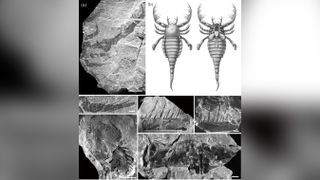Ancient dog-size sea scorpion unearthed in China
The sea scorpion was the apex predator of its time.

A 3.3 foot-long (1 meter) sea scorpion prowled the seas of what is now China some 435 million years ago, using its giant, spiny arms to ensnare prey.
Palaeontologists recently discovered the remains of this scorpion (Terropterus xiushanensis), which was a eurypterid — an ancient arthropod closely related to modern arachnids and horseshoe crabs, the researchers wrote in the Nov. 30 issue of the journal Science Bulletin.
Related: See images of a primordial sea scorpion
Its barbed limbs "were presumably used for prey-capture, and analogies can be drawn with the 'catching basket' formed by the spiny pedipalps of whip spiders … among the arachnids," study co-author Bo Wang from the Nanjing Institute of Geology and Palaeontology and Center for Excellence in Life and Paleoenvironment at the Chinese Academy of Sciences, and colleagues wrote in the new study. Pedipalps are the front-most appendages of arachnids. Usually dedicated to transferring sperm from male spiders to female mates, in some arachnids, such as whip spiders, pedipalps have become adapted to snatch prey.

The fearsome beastie lived during the Silurian period, between approximately 443.8 million and 419.2 million years ago. At this time, the scorpions would have been the apex predators in their underwater stalking grounds, pouncing on unsuspecting fish and mollusks; scooping them up in their pedipalps; and shoving them into their mouths.
Eurypterids came in many sizes, with the smallest about the size of a human hand and the largest as big as an adult human, Live Science previously reported. The newly described species, T. xiushanensis, is the first discovered belonging to the family Mixopteriade in 80 years, the researchers say.
"Our knowledge of these bizarre animals is limited to only four species in two genera described 80 years ago: Mixopterus kiaeri from Norway, Mixopterus multispinosus from New York, Mixopterus simonsoni from Estonia and Lanarkopterus dolichoschelus from Scotland," Wang and colleagues wrote in the study.
Sign up for the Live Science daily newsletter now
Get the world’s most fascinating discoveries delivered straight to your inbox.
T. xiushanensis is also the first mixtopterid to be discovered in what would have been the supercontinent of Gondwana, which formed after the larger supercontinent Pangaea cracked in two.
"Our first Gondwanan mixopterid — along with other eurypterids from China and some undescribed specimens — suggests an under-collecting bias in this group," the researchers wrote in their study. "Future work, especially in Asia, may reveal a more cosmopolitan distribution of mixopterids and perhaps other groups of eurypterids."
Originally published in Live Science.

Ben Turner is a U.K. based staff writer at Live Science. He covers physics and astronomy, among other topics like tech and climate change. He graduated from University College London with a degree in particle physics before training as a journalist. When he's not writing, Ben enjoys reading literature, playing the guitar and embarrassing himself with chess.
Most Popular


